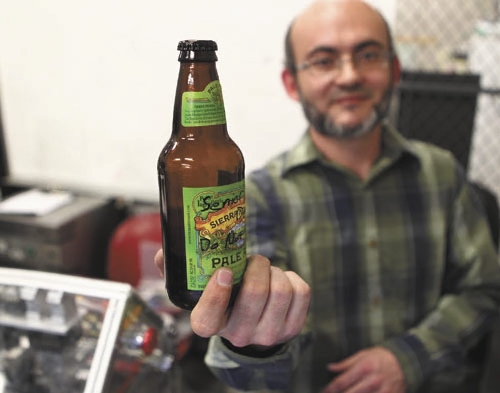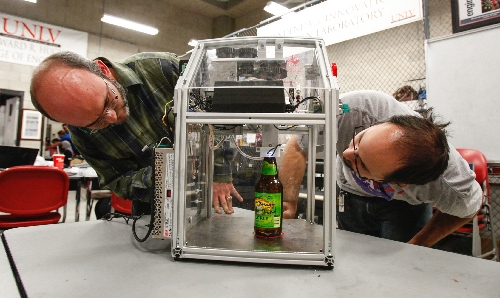A little beer and a lot of ingenuity lead to new invention



When you are a mechanical engineer, you see problems everywhere that need fixing.
When you are a college student, you drink beer.
Put them together, and you have a senior project.
"We joke that we’re the heaviest drinking engineering team on campus," said Dan Sigler, 32, one of four UNLV students who have teamed up to build a better beer bottle capper.
The team, which has dubbed itself Team ABC, for Automatic Bottle Capper, is one of 32 teams in this semester’s Senior Design Competition at the university.
Every semester, senior engineering students are required to produce projects to be judged by faculty and industry leaders before graduation.
Often, the things the students come up with solve real-world problems. In the past, they’ve built a box that keeps bananas from spoiling, a front door that unlocks itself and a solar-powered scooter.
This semester’s projects will be on display today at the UNLV Foundation Building on campus.
They include a gizmo that helps the old and infirm put their socks on, a motion-controlled computer robot game, an adjustable, motorized TV wall mount, and, of course, the bottle capper.
"It’s so obvious," said team member Jinger Zeng, 23.
These students enrolled at the university in the past few years to study mechanical engineering. They met. They ran into then-professor Daniel Cook, who has since left the university.
The professor happened to be into home brewing. He passed along a few tips and some equipment to the students as he took off.
A love affair was born. A team was formed. Nicknames were created.
Sigler, "The Brain," loves strong beer.
Tony "The Machinist" Filipiak loves pilsners.
Amber "The Math Girl" Sypien and Zeng, "The Chinese," love mead, a type of honey wine.
It takes anywhere from three to six weeks to brew beer at home. They brew about five gallons at a time. When it’s done, there are basically two choices (three if you count drinking it all immediately): Put it in a keg or bottle it.
These guys prefer bottling. It allows the beer to carbonate itself naturally.
They wash and reuse beer bottles. That’s easy. They buy bottle caps. That’s easy too.
But to get a cap on those bottles? Not so easy.
They use what’s called a hand capper, which looks like a disfigured pair of pliers. It basically squishes the cap onto the bottle.
But bottles break all the time. About two to five of every 50.
"That’s painful when you’ve just spent all that time brewing beer," Sigler said.
Because these students are engineers, they engineered a solution. They asked the authorities – their professors – if they could make the thing their senior design project.
Sure, the authorities said.
They tossed around a few ideas. A better hand capper? No. It has been done.
What about an automated capper? There didn’t seem to be one on the market at all. Not one designed for home brewing, anyway.
So the team designed, built and tested a machine that puts the caps on automatically. It’s about the size of three or four phone books stacked on top of each other. It takes about 20 seconds to put the cap on, which is just about how long it takes to fill a bottle.
They’ve tested it with maybe 50 filled bottles and 100 empties.
Not a single one has broken. The secret is applying pressure evenly, which is tough with a hand capper.
"We wanted a mechanism that would constrain the force to be perfectly vertical," Sigler said, sounding like an engineer at last.
Unlike many of the teams that enter the university’s senior design competition, these students aren’t going to seek a patent. They don’t have visions of multi-million-dollar business deals dancing in their heads. They don’t expect to make a dime from their invention.
They’re giving it away by posting the plans on the Internet for anyone to use.
"There’s no reason to patent it," said Zeng, who acknowledged that they all have a little bit of hippie in them.
"We’re engineers," Sigler said. "We get into the process of making stuff."
Not selling stuff.
Contact reporter Richard Lake at rlake@reviewjournal.com or 702-383-0307.












